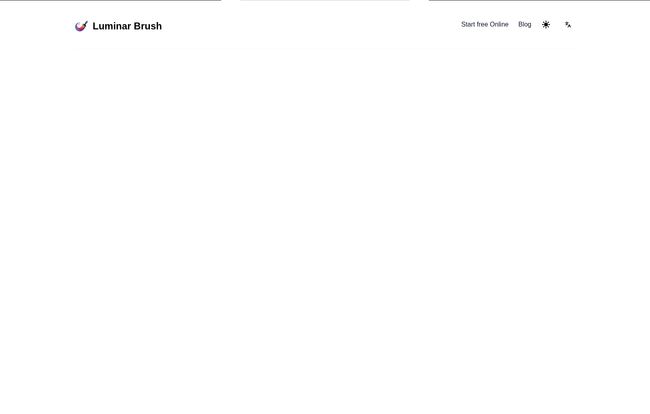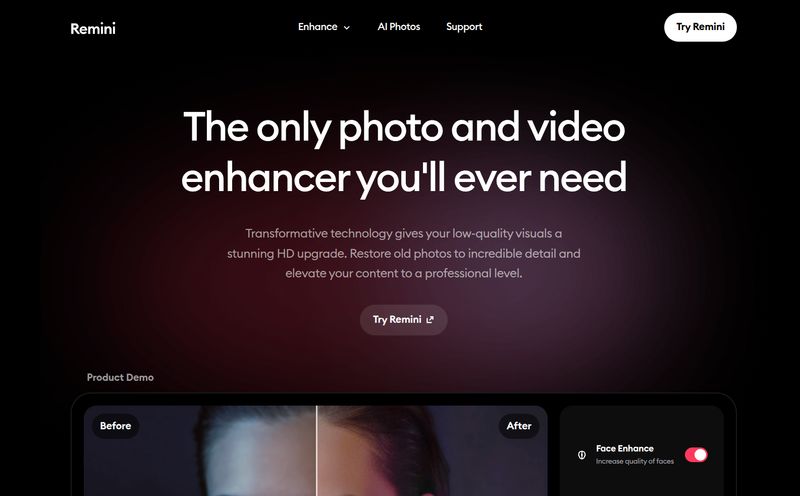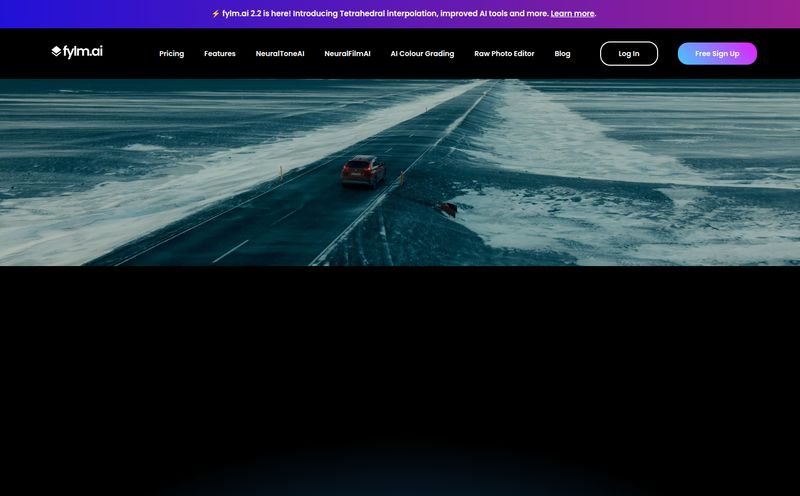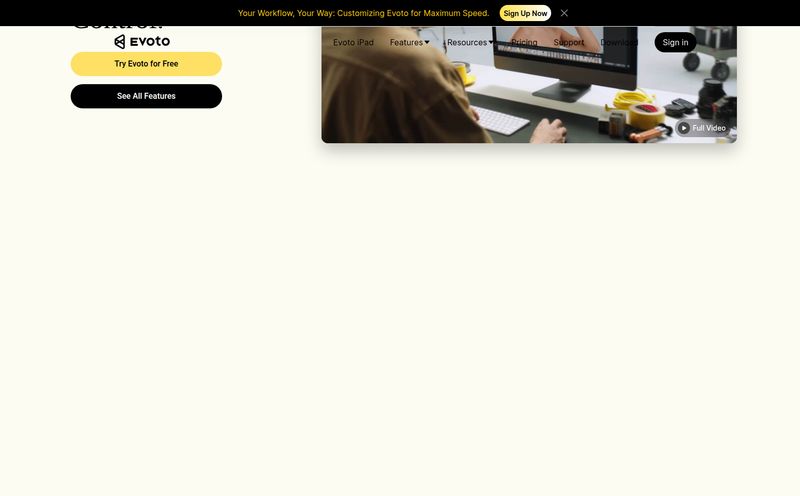We've all been there. You snap a photo that has everything going for it. The composition is perfect, the subject is on point, the moment is captured… but the lighting? The lighting is flat, or it's harsh, or it's just plain wrong. For years, fixing it has been a tedious dance in Photoshop or Lightroom, nudging sliders back and forth, painting in shadows and highlights, and hoping for something that doesn't look completely fake. It's a grind.
So, when a new tool pops up on my radar, especially one with a pedigree like this one, my ears perk up. The tool is called Luminar Brush, and it’s not just another filter pack. This thing is an AI-powered illumination tool. And get this—it's from Illyasviel, the same brainiac who gave us ControlNet. If you've been anywhere near the AI art or tech space in the last couple of years, you know that's a massive deal.
Honestly, the tool is so new that when I first went to check out the website, I was greeted by a friendly 404 error. Some might see that as a bad sign. Me? I see it as getting in on the ground floor. The digital paint is still wet on this one, folks.
So What is Luminar Brush, Exactly?
Let's cut through the jargon. Luminar Brush is designed to do one thing and do it exceptionally well: manipulate light in your photos. Think of it less like a photo editor and more like a digital lighting director. Instead of just brightening or darkening pixels, its AI is built to understand the physics of light, shadow, and dimension within an image. It can take a photo with boring, uniform lighting and allow you to essentially repaint the light itself. Want a dramatic side light? A soft, ethereal glow? A moody, cinematic look? That’s the promise here.
It's built on a pretty clever framework that separates the process into two main stages. First, it uses something called 'delighting' technology to analyze the existing light in your photo and neutralize it, creating a sort of blank, evenly lit canvas. Then, you get to be the artist. You interactively 'brush' on new light sources, and the AI synthesizes them realistically onto your image. It’s a fascinating approach that gives you a ton of creative control.
The Mastermind Behind the Magic: Why Illyasviel Matters
I can't stress this enough: the name attached to this project is a huge part of the story. Illyasviel is the creator of ControlNet, a technology that fundamentally changed the game for AI image generation. Before ControlNet, getting an AI to generate an image with a specific pose or composition was, frankly, a crapshoot. You'd roll the dice and hope for the best.
ControlNet gave artists and creators a way to guide the AI with incredible precision using things like stick-figure poses, depth maps, and sketches. It was a leap forward for intentional, controllable AI art. The fact that the same developer is now turning their attention to the problem of photo relighting... well, that tells me this isn't just a gimmick. It's a serious attempt to solve a real problem with sophisticated tech.
How It Works: The Techy Stuff, But Fun
The Two-Stage Framework
I mentioned this before, but it's worth a closer look. Think of it like this: you want to repaint a classic car. You don't just spray the new color over the old, chipped paint, right? No. You strip it down to the primer first. That's Stage One of Luminar Brush. The AI's delighting feature strips away the existing, often problematic, lighting scheme of your photo, leaving a neutral base. Stage Two is the fun part—the custom paint job. You use the brush to tell the AI, 'I want a light source over here, and I want it to be warm and soft'. The tool then intelligently renders how that light would fall across the surfaces of your image, creating realistic highlights and shadows in real time.

Visit Luminar Brush
Features That Actually Matter
The feature list is full of cool-sounding terms, but what does it mean for your workflow? The Intelligent Light Synthesis is the core of the magic, creating those believable effects. But for me, the Real-Time Preview is the showstopper. There's nothing worse than moving a slider, waiting for a render, hating it, and starting over. Seeing your changes happen instantly as you brush is what makes a tool feel intuitive and creative rather than technical and clunky. It closes the gap between your idea and the final result, which as any creative pro knows, saves an incredible amount of time and frustration.
Who Is This Tool Really For?
I can see a few groups getting really excited about this. First, portrait photographers. Bad lighting on a face can ruin a perfect shot. Being able to add a perfect Rembrandt light or a soft fill light in post-production, without it looking fake, is a dream. Second, anyone in ecommerce or product photography. Imagine being able to take one simple, well-lit shot of your product and then generating multiple versions with different lighting setups to match various marketing campaigns. That’s a huge time and money saver.
And of course, digital artists and social media creators. The ability to quickly add dramatic, eye-catching lighting effects can make your content stand out in a crowded feed. It’s for anyone who understands that light isn’t just about visibility; it’s about mood, emotion and storytelling.
My Honest Take: The Good, The Bad, and The TBD
So, what’s my verdict? I'm cautiously optimistic. The potential here is enormous. The ability to save time and achieve professional-level lighting effects with an intuitive, AI-powered brush is a massive plus. For my own workflow, churning out blog and social media images, this could easily shave hours off my week.
On the flip side, the potential cons are what you'd expect. It's an online tool, so you'll probably need a stable internet connection. And if there's a free version, I'd bet my bottom dollar there will be limitations on image size or resolution. That’s just the standard playbook for these kinds of tools.
The Big Question: What About the Price?
This is the big unknown. The official site is still finding its feet (hence the 404 page I found), and there's no pricing information available just yet. This could mean a few things. It might be in a free beta period to gather feedback. It could be an open-source project, though that seems less likely for a 'Luminar' branded product. My guess? We'll see a freemium model: a basic, perhaps limited, free version with a Pro subscription to unlock the full suite of features. I'll definitely be keeping my eye on this.
Luminar Brush vs. The Field
How does this stack up against the giants like Adobe Photoshop or even its sibling-in-name, Skylum's Luminar Neo? It's a different beast. Photoshop's Generative Fill is incredible, but it's a generalist. Luminar Neo has great AI tools, but they're often more about sky replacement or portrait touch-ups. Luminar Brush appears to be a specialist. It’s hyper-focused on just lighting. And in my experience, specialized tools that do one thing incredibly well often outperform the bloated, do-everything platforms for that specific task. It's not trying to be Photoshop; it's trying to be the best relighting tool on the market.
Final Thoughts: A Tool to Watch
So, is Luminar Brush worth your time? If you're a photographer, artist, or creator who obsesses over lighting, my answer is a resounding yes. Even with the website hiccups and lack of pricing, the pedigree of its creator and the laser-focus of its purpose make it one of the most interesting AI tools to emerge this year. It represents a shift from generative AI (creating things from scratch) to assistive AI (making your existing work better, faster).
This isn't about replacing your skills; it's about giving you a better, smarter brush to paint with. And I, for one, can't wait to get my hands on it and see if it truly lives up to the hype.
Frequently Asked Questions
- What is Luminar Brush?
- Luminar Brush is a specialized AI-powered image editing tool designed specifically for adding, changing, and enhancing the lighting effects in photographs. It allows users to interactively 'brush' on light in real-time.
- Who created Luminar Brush?
- It was developed by Illyasviel, who is famously known in the tech community as the creator of ControlNet, a groundbreaking technology for controlling AI image generation.
- Is Luminar Brush free to use?
- As of now, there is no official pricing information available. The tool is very new, and it may be in a beta testing phase. It's possible it will operate on a freemium model in the future, with a free basic version and a paid pro version.
- How is Luminar Brush different from Photoshop?
- While Photoshop is a comprehensive, all-in-one photo editing suite, Luminar Brush is a highly specialized tool. It focuses exclusively on mastering lighting. This specialization allows it to offer a more intuitive and powerful workflow for relighting tasks compared to a general-purpose tool.
- Can I use Luminar Brush for my product photos?
- Absolutely. It seems ideal for product photography. You could shoot a product under simple, clean light and then use Luminar Brush to add various creative or dramatic lighting styles for different ad campaigns or website banners, saving time and resources.
- What is 'delighting' technology?
- 'Delighting' is the term used for the AI's ability to analyze an image and remove or neutralize its existing lighting and shadows. This creates a clean, flat base image, making it much easier to add new, artificial light sources realistically.
Reference and Sources
- ControlNet on GitHub (for creator background): https://github.com/lllyasviel/ControlNet
- Skylum Luminar (for comparison): https://skylum.com/luminar



